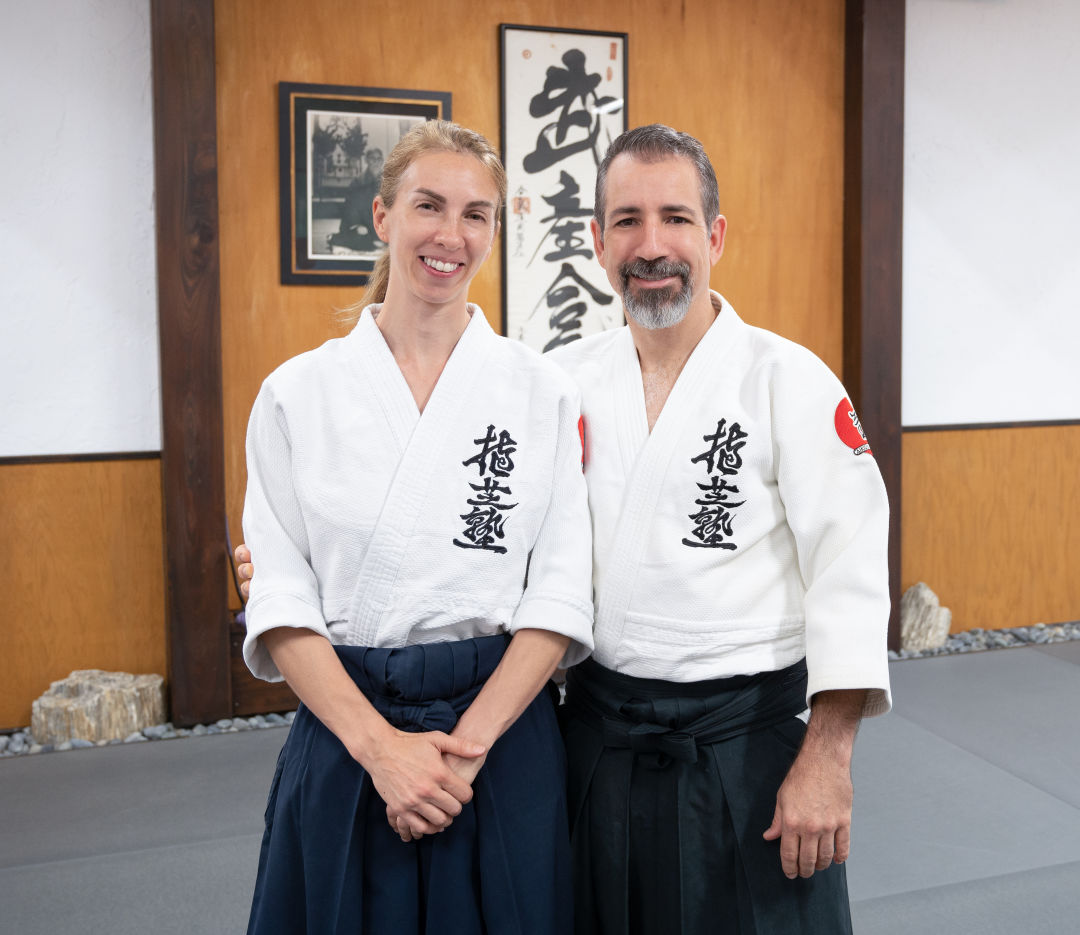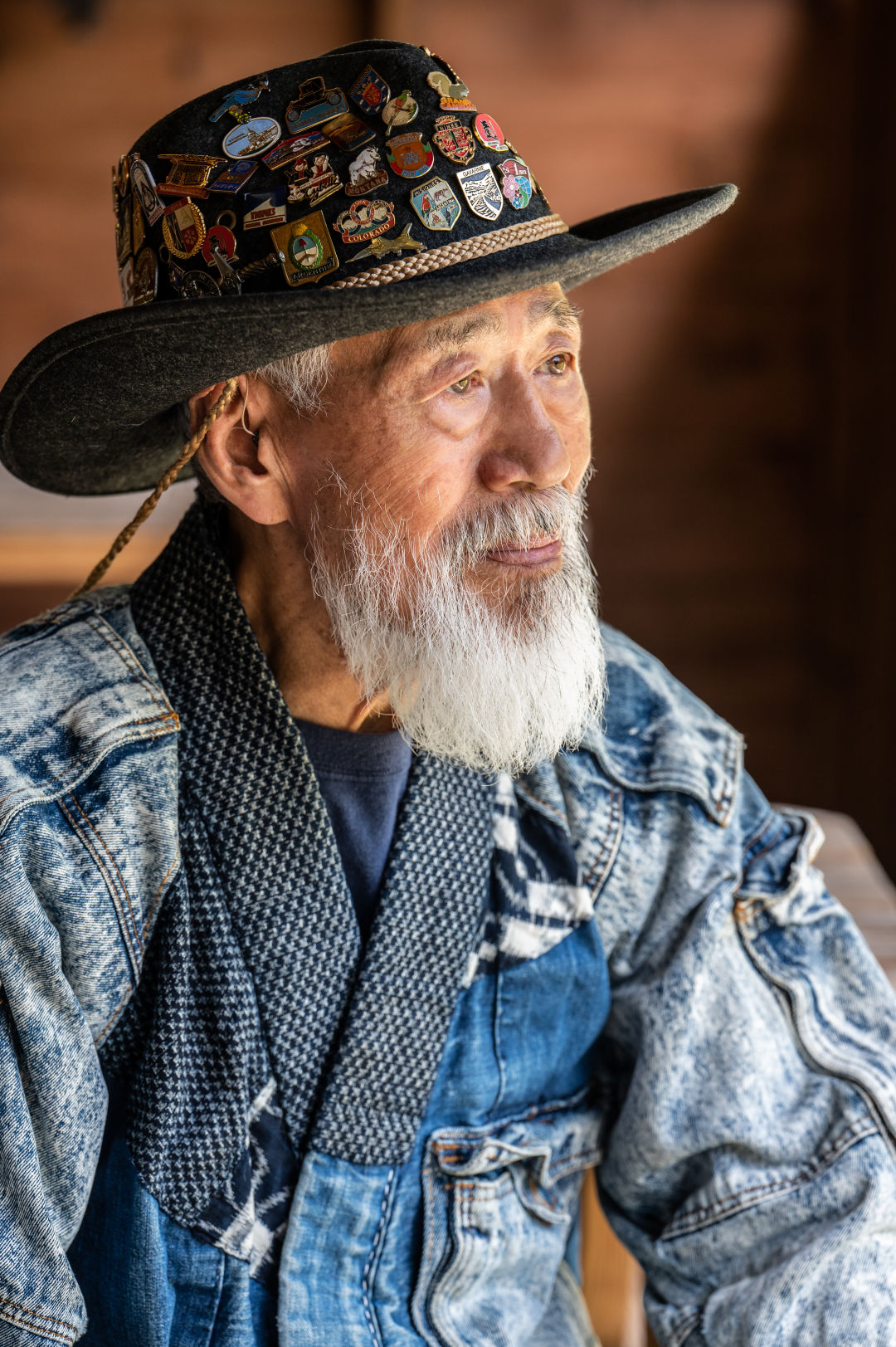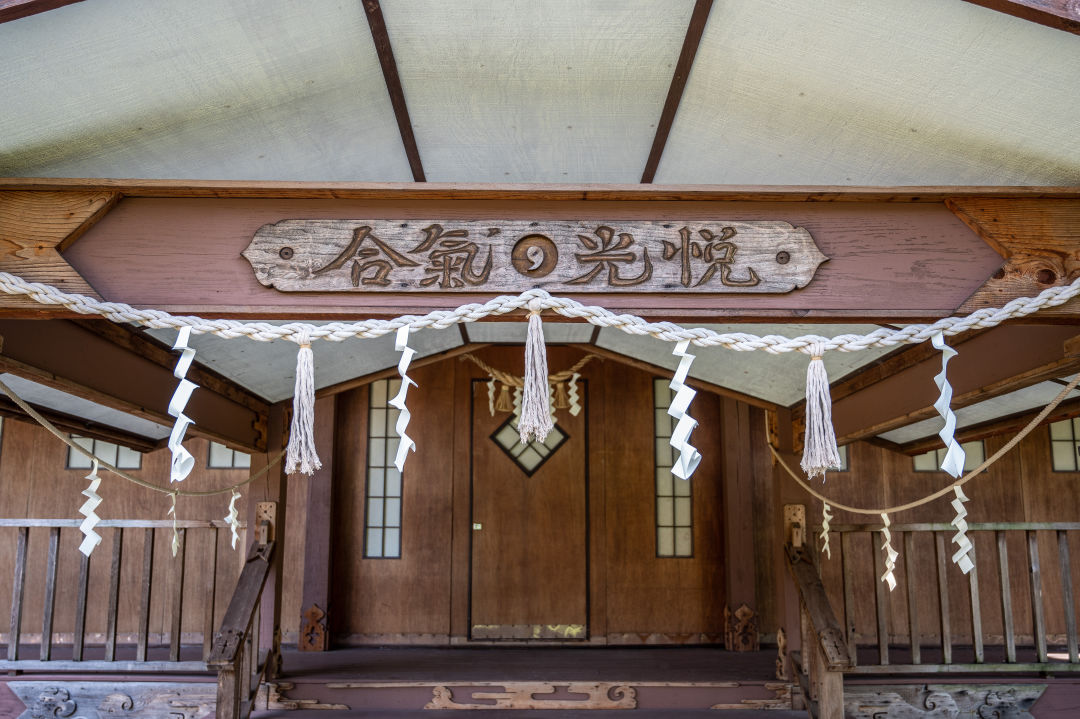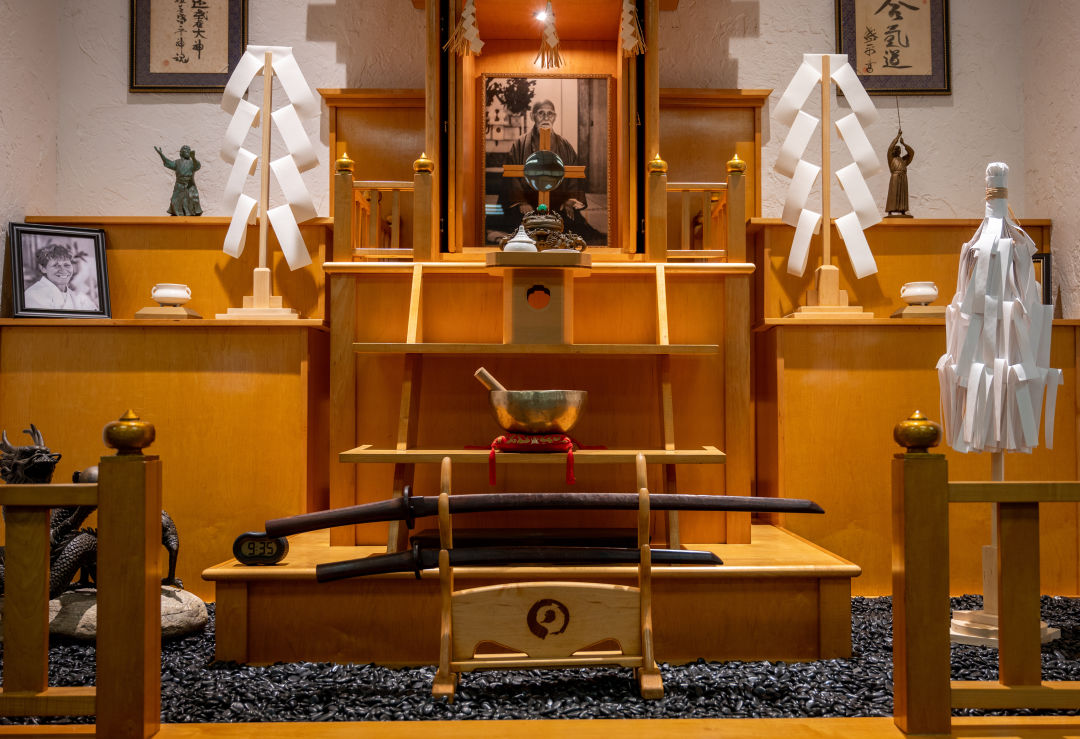
The Aikido Master of Myakka
When Mitsugi Saotome walked into Sarasota’s 12th Street Dojo on a warm evening in mid-May, he looked like he had walked straight out of a Japanese Western. Small in stature, he wore a wide-brimmed black felt cowboy hat, a handmade denim vest over a long-sleeved shirt, and jeans. But this was no movie—this was a man venturing from his home in Myakka to teach an aikido class in the first dojo he created in the U.S. nearly 50 years ago.
Today, Melissa Bell is the dojo cho, or chief instructor, at the 12th Street Dojo. She received the Ueshiba Juku designation from Saotome, meaning she is a carrier of the teachings of Morihei Ueshiba, the founder of aikido, as transmitted through Saotome.
Before Saotome arrived at the dojo, 15 or so students lined up at the base of a mat facing a shrine gate on the opposite wall. Within the gate is a black-and-white photo of Ueshiba (who is referred to as O-Sensei, an honorific meaning "great teacher"), a kanji banner and a wooden sword, staff and knife. A version of this shrine can be found in aikido dojos around the world. Bell walked to the center of the mat, wearing what looked like casual samurai clothing: a white gi overlaid with a dark blue hakama, which looks a bit like a skirt, but is in fact pants with a cotton belt of the same color, called an obi, knotted in front. All the students wear the same clothing, except the beginners, who wear only the white gi.
Bell sat on her heels facing the shrine and bowed, and the students imitated her movements. She raised her hands and the space resounded with two unified claps. Then the training began.
Saotome entered about a half hour into the session and, after changing from Myakka cowboy into modern-day, samurai-like aikido clothing, he stepped onto the mat, bowed to the photo of Ueshiba, walked to the center and proceeded with the same ritual that Bell had initiated earlier.
He began the session with a short lecture. His English is partial, and he repeated himself, offering examples of what he was discussing and asking, “Know what I mean?” The students responded with a unified, “Yes, Sensei!”

Mitsugi Saotome
Image: Barbara Banks
Saotome then talked about his early days in aikido—how he was just a teenage boy studying judo when he began training in aikido. He later became uchi-deshi, or a live-in student, for Ueshiba, and when he mentioned his first meeting with Ueshiba, his countenance shifted to awe. Saotome’s book Aikido and the Harmony of Nature—translated and edited by his late wife Patricia, an American and aikidoist he married after he moved here—describes the moment: “I looked into his eyes and was arrested by the powerful gravity of his spirit.”
Saotome's short lecture ended with a demonstration of technique. Don Ellingsworth, an aikidoist who often presents attacks for Saotome, lunged for Saotome, who moved swiftly and easefully, with Ellingsworth flying through the air and rolling away from Saotome's throw. Saotome then instructed the students to pair up and practice what he had just shown them.

Julie Tollen and Don Ellingsworth
Image: Barbara Banks
After the training, Saotome and others gathered at Mandeville Beer Garden for dinner. Ellingsworth, who lives on the Myakka property with his wife Julie Tollen, was in attendance, and I was seated next to Saotome. He was deciding if I would be permitted to interview him and visit the Aiki Corral, where Saotome and his students built an Aiki Shrine in the late 1990s. It’s a place of retreat and training for aikido black belts and those issued a special invitation. The Myakka shrine is the only one outside of Japan, created by students who trained with Ueshiba.
Saotome didn’t speak until the end of the meal, when he turned to me to tell me that America has the most potential of any country in the world to offer an example of peace because of our diversity. Saotome is 86 years old. He was 8 when an American atomic bomb decimated Hiroshima in 1945 and 9 when the United Nations formed, hoping to succeed in creating world peace where the League of Nations had failed after World War I.
The founder of aikido, Ueshiba—Saotome’s teacher—had lived through that history as an adult. Born in 1883 to a samurai lineage in a country bent on war, Ueshiba had more spiritual inclinations. With years of martial arts training under his belt, he began following a female-led religious sect broken off from Shintoism, and by 1943, he had experienced three realizations that informed what he came to call aikido.
His description of these is quoted in Saotome’s book: “The Way of the Warrior has been misunderstood. It is not a means to kill and destroy others. To smash, injure or destroy is the worst thing a human being can do. The real Way of a Warrior is to prevent such slaughter—it is the Art of Peace, the power of love.”
I was sitting next to a man, his cowboy hat resting between us on a bench at a beer garden, who has a living memory of world war and the striving for global peace that arose in its wake. He agreed to an interview with me, and Ellingsworth and Tollen offered to make me lunch and give me a tour of the Aiki Shrine.

Mitsugi Saotome
Image: Barbara Banks
A core understanding of aikido can be found in its name: Ai means harmony, unity, balance and joining; ki means spirit, life-force and universal creative energy; and do means way or path. It differs from other martial arts because of its focus on subduing an attack while protecting others, including the attacker. There are no aikido techniques designed to attack first or cause harm.
Aikido officially came to the U.S. by way of Hawaii in 1953, but one of the most influential moments in its history in this country came in 1975 with the arrival of Saotome in Sarasota.
John Messores began studying with Saotome that same year and has since received the Ueshiba Juku designation, like Bell. “Every shihan, or master instructor, is expected to create their own aikido," Messores says. "It’s a little like jazz. What was noticeable about Saotome Sensei was that he had a more martial technique and attitude. It involved a willingness to have people coming at you fast and hard and dealing with it.”
Messores, who now lives in Panama City, trained in karate in the late '60s, but once introduced to aikido at the Sarasota YMCA, it slowly became his main practice. People were friendly and not competitive and, in turn, he found himself becoming more open. The only problem was that the instructor of the Sarasota dojo at the time, Bill McIntyre, was still only a first-rank black belt and the community needed a higher-ranking teacher to advance.
In 1973, McIntyre traveled to Tokyo, Japan, to train at the Hombu Dojo, the aikido world headquarters, for six weeks. While there, he encountered Saotome, one of the dojo's highest-ranking teachers. Saotome often joined foreigners for coffee after classes, sharing stories about his experiences with O-Sensei—who had passed away just a few years before, in 1969.
At one point, McIntyre asked Saotome if he would consider sending a young Japanese instructor to teach at the Sarasota dojo. Three days later, Saotome surprised everyone by announcing that he himself would go.

Mitsugi Saotome in Sarasota in 1978
Image: Courtesy Photo
He wrote about that decision in the handbook for the Aikido Schools of Ueshiba, the organization he created after arriving in Sarasota. “I meditated on O-Sensei’s spirit for three days and three nights and I felt it was his wish that I should go,” he wrote. “This country is a great experiment, a melting pot of people from many different cultural backgrounds living together, the world condensed into one nation. The goal of Aikido and O-Sensei’s dream is that all the people of the world live together as one family, in harmony with each other and with their environment. The United States has the opportunity to set a great example.”
According to Messores, Saotome’s decision to move here forced him to start over. “He was one of the senior instructors in Tokyo, in line to become the chief instructor, which is a really big deal,” Messores says. “He would have stayed there another 20 years before that happened. He also wanted to open himself up to the world.”

An aikido training session in Sarasota in1978
Image: Courtesy Photo
Saotome was 38 years old when he arrived at Sarasota Bradenton International Airport in 1975, where he was greeted by several students, including McIntyre. Messores says, “I saw him in the dojo the next day with his shirt off on the mat and he was doing something that reminded me of karate. I didn’t expect that. He was just doing standard little movements: blocking, punching. It told me that he was a different kind of aikido instructor.”
Right away, Saotome led long, intense days of training. “We were pretty clunky and slow, but he was pushing us,” Messores says. “He made his aikido exciting. It was full speed. I know now that he was training our instincts.”
Messores says that developing an ability to respond to surprise is necessary in aikido. “He showed us that aikido was boundless in its creative energy,” Messores says. “We tried really hard to show him we wanted his teaching. We were just ordinary people and this was the mid-’70s. Here I had this high-ranking master instructor come to my hometown of Sarasota and it was like nothing I ever expected.”

The Aiki Shrine
Image: Barbara Banks
The Myakka Aiki Shrine is located near a sharp curve on Singletary Road and is easy to miss. The only sign is a large wooden frame set back behind some trees, flanked by lush greenery on either side.
Saotome lives on the property in a small, newly built home with high ceilings and a spacious front porch. Heading outside to walk to the shrine, we pass an older, larger house with a rope stretched across the front steps to warn people that the steps have rotted and collapsed. Tollen says the house requires constant repairs. Saotome walks behind us, holding the upper part of one of the many tall canes he has shaped from found wood. The sun glints off its polished top end.
We round the corner where we find the Aiki Shrine, situated between old oaks and stands of bamboo, in full sun. It’s modest and yet not, with a wide roof that shades a wraparound porch. Entrants pass through a large, free-standing gate before walking a short path to the steps of the shrine, which have wooden cutouts in the shape of clouds. As I stop to take it in, Saotome walks through the gate and up the steps while Tollen explains the waist-high, decorated trunk of wood near the gate.

Mitsugi Saotome
Image: Barbara Banks
“For training sessions, we place a bowl here where people can wash their hands before entering the shrine,” she says. It’s a symbolic gesture to “wash away the worldly self before going in to work on your ideal self,” she says.
A large beige rope hangs from the entrance gate with three large tassels and three pieces of white paper folded to look like lightning to express a connection between sky and ground, or heaven and earth.
Saotome walks inside as Tollen demonstrates how three of the walls can fold back for an open-air training session. “As you’re training,” Bell tells me, “the breeze comes through, and you hear the rustling of the leaves in the bamboo, the birds or cicadas chirping in the distance. Nature is right there and you feel more connected to it—physically, spiritually. That gets folded into your practice in a way that doesn’t on regular training days."

Inside the Aiki Shrine
Image: Barbara Banks
I follow Saotome and Tollen inside, noticing how the tatami floor gives way just enough to soften falls. Like other aikido dojos, there is a shrine with a photograph of the founder and other kanji drawings, as well as kanji banners made by O-Sensei himself. It is all more elaborate than the typical dojo. Entering the space in the correct way or caring for the place engenders respect for the practice.
High-ranking members of Aikido Schools of Ueshiba come here for retreats and a chance to train with Saotome—valued because transmission of the art form happens through direct contact and touch. “The essence of aikido is something that is felt physically or energetically," Bell says. "It’s something that happens when you’re in the physical presence, direct contact in practice. It’s housed in real people and transmitted through direct contact.”
Ellingsworth describes the difference between training at the shrine with Saotome and regular dojo sessions. “Beginners learn to draw the lines of the alphabet. Black belts learn to write," he says. "And then you come here and you learn to write poetry."
Saotome heads over to the altar. He pulls a short wooden rod from a large crystal bowl and uses it to give the bowl a knock. Out comes a resonant sound that spreads throughout the space. We stand, quietly listening, until he stops the sound and then knocks the rod against a smaller brass bowl.
As we walk back toward the house, Tollen talks about the garden they’re planning and how they care for different plants. Saotome has gifted the property to the Aikido Schools of Ueshiba. “Sensei is getting older," Tollen says, "and he has said several times that now it is for us to care for this space."

Mitsugi Saotome
Image: Barbara Banks
In Saotome’s living room, I find a couch and two cushioned black leather chairs facing a television. Behind the chair where Saotome sits is a small altar and in front of him is a small table with crafting tools and materials. Below the television are hundreds of DVDs. It looks as though he owns a copy of every Zatoichi movie ever made. Zatoichi is Japan’s long-running film series about a blind, aimless man who is secretly a highly skilled swordsman—a talent that only emerges when he must protect the innocent from gangs or oppression. His sword is hidden in his cane and he is always underestimated.
Saotome has taught what he calls “biofeedback” seminars, in which he tells students that aikido is not “magic,” but is instead “biological.” But it’s hard not to imagine there being some magic to the practice when you watch old video recordings of O-Sensei—small, with white hair and a long white beard, his old age clearly established—throwing young students across a mat. In one clip, when a student rushes to attack, O-Sensei’s movement is too swift and subtle to even see as the student flips into the air and lands behind him. Saotome, now sitting quietly and cutting strips of cardboard, has thrown Ellingsworth similarly, sending him flying through the air more than once at the 12th Street Dojo.
As a young man, Saotome left a career as a mechanical engineer with Honda to pursue aikido. “Physical mechanics, biological mechanics,” he says. “My hand is an amazing mechanic. The human hand is incredible.” He emphasizes the word “incredible” with a kind of awe. He points to his hands and fingers and slowly touches each of the fingertips on his right hand. He is gentle and takes his time touching his fingers, closing his eyes with his head angled slightly up.
When asked about the Zatoichi films, Saotome stands up and reaches for one of his many wooden canes to demonstrate how Zatoichi would sense the world around him with his cane, and he moves to show how Zatoichi would pull his sword from the cane. Swinging the cane around the small living room, raising it in the air and bringing it around to face attackers from behind, all of his movements are graceful and exact.
In Aikido and the Harmony of Nature, Saotome provides a translation of O-Sensei’s teachings, as well as a detailed manual of aikido’s technique and teachings. He writes about the beginning of the universe and offers a perspective on truth, nature’s justice and the training process.
Here in his living room, he sits back in his chair and demonstrates gestures. He holds up his middle finger and then switches to a gesture for inviting someone to come closer to note the difference and says, “Vibration.” He says that O-Sensei was sometimes severe on this point, telling him, “Saotome! Wrong attitude! Arrogant!” But he says he also had the “most amazing, very gentle, warm heart.”
I ask Saotome about his hopes for the future of aikido and its hundreds of dojos around the world. “Everybody helping each other, teamwork,” he says. But what about the inevitable conflicts, or disagreements? “Without the experience of conflict,” he wrote in his book, “we cannot know harmony.”